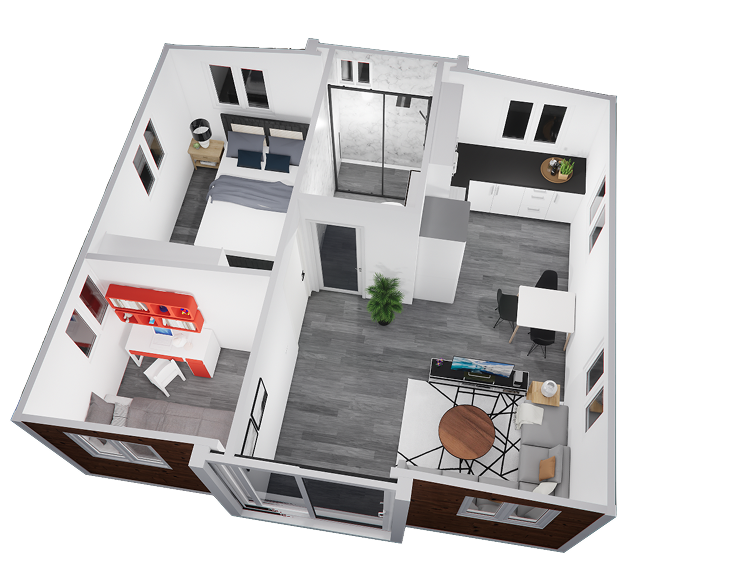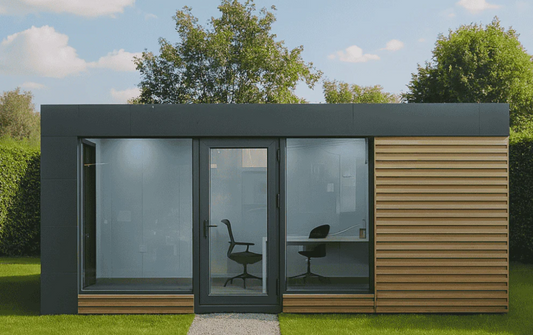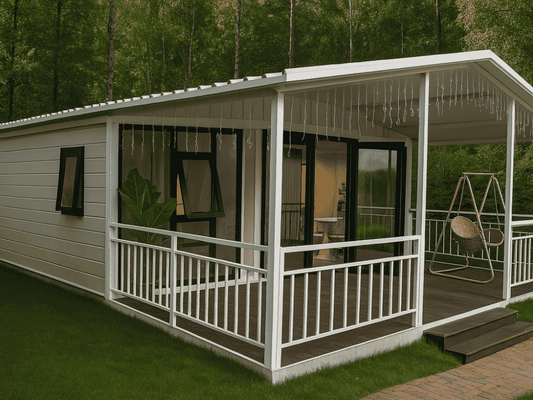You’re here because you want to make the most of your property.
Maybe you’re considering adding a prefabricated ADU for a relative or creating a rental space for extra income. Or perhaps you’re torn between tearing down a wall and expanding more rooms or building a granny flat from the ground up. Then you saw some talk of prefab units online, and are wondering if they are worth it.

The Rise of ADUs in Modern Housing
In 2022, California issued over 23,000 ADU permits, up from fewer than 5,000 in 2017. That’s a 360% increase, driven by new laws making ADUs more accessible. In Los Angeles alone, 7,160 ADU permits were approved—dwarfing the the 1,387 permits for single-family homes.
They are the hot new trend in modern property upgrades. But is getting an accessory dwelling unit the right move for you?
Analyzing the cost, timelines, and value will help you decide which option fits your goals, budget, and lifestyle.
What Are Prefab ADUs and Home Additions?
An accessory dwelling unit (ADU) is a smaller, independent residential dwelling unit located on the same lot as a stand-alone single-family home. It's built as a detached or attached unit to the primary dwelling. You've probably heard such units being called accessory apartments, secondary suites, or granny flats.
Prefabrication makes having them a whole lot easier
Prefab Accessory Dwelling Units
Prefab ADUs are secondary units built in a factory using modular construction and then delivered to your backyard for quick installation. They’re versatile, offering options like tiny homes and backyard cottages. A detached ADU can serve as a rental unit or guest house.
Standard features include:
-
Spacious bedroom and living areas.
-
Complete kitchen and bathroom.
-
Utility connections, including electricity, water, and sewage.
-
Insulation and climate control for energy efficiency.
-
Customizable interior design and finishes.
To build an ADU, start by making sure you comply with your local building department’s regulations and zoning laws. You'll need to obtain the necessary permits and approvals, meet the minimum size requirements (usually between 150 and 400 square feet), and ensure the ADU has proper utility connections and is easily accessible.

Home Additions
Traditional home additions expand your main house by building directly onto it.
Maybe you want a bigger kitchen so everyone can hang out while you cook. Or an extra bedroom for when family visits. How about a playroom to keep the kids' toys in one place? Even a home office for quiet, focused work.
The appeal here is integration—it feels like a smooth extension of your existing home.

Side-by-Side Prefab ADUs vs. Home Additions
Here is how they stack up in different areas:
1. Cost Comparison
Every dollar counts when improving your property.
On average, homeowners spend $21,000 to $73,500 on a home addition, with the national average landing around $50,000. But costs can climb quickly. Add in high-end finishes, custom fixtures, or unique architectural designs, and the price can easily set you back six figures.
For example, a 20x20 room addition typically ranges from $50,000 to $100,000, depending on its purpose and features.
Forbes puts the cost per square foot for such projects at $80 to $200. This depends on factors like the location on your home, the materials you choose, and the skills of the contractor you’ve hired.
Compare that to an ADU like HomeDrop Compact Haven that starts at just $17,000. A prefabricated ADU is the smart choice if you’re looking for affordable housing options. Why? Because they’re factory-built, cutting down on labor and material construction costs.
Avoiding Budget Overruns
Prefab accessory dwelling units also keep surprises to a minimum. Since they’re built off-site, you avoid costly delays, weather issues, or unexpected additional costs like extra labor or materials.
Home additions, on the other hand, are infamous for blowing budgets. Hidden fees—permits, contractor markups, and temporary site fixes—add up fast.
Want to save even more? Prefab ADUs are incredibly efficient to install. With shorter timelines, your site stays free of long-term disruption. That means less time waiting and more time enjoying your new space.
2. Timeline and Installation Process
From order to move-in, the entire installation process for a prefab ADU can be done in just two months. Compare that to the construction time for home additions, which often drags on for 6-12 months (or more).

Much of the work with ADU installation happens off-site. The site work, like prepping your backyard and laying the foundation, is minimal. This means less mess, less noise, and fewer headaches for you.
And it’s not just about speed.
Companies like HomeDrop act as a one-stop shop, handling everything—from permits to delivery to utility hookups. Their team of experts speeds along the process. Even the final inspection is taken care of, so you can focus on the fun part: enjoying your new space.
With home additions, it’s a different story. The timeline depends on your contractor, weather, and unforeseen delays. And because everything happens on-site, your home can feel like a construction zone for months.
3. Customization and Design
Your space should feel like you. Period.
With prefab ADUs, the possibilities are endless. You can design everything—from the interior layout to the finishes—using user-friendly 3D tools. Want a spacious bedroom with oversized windows to let the light pour in? Done. Need a studio shed for your side hustle or an art studio for your creative projects? Easy.
These units can also be transformed into home offices, a private home gym, or even a guest retreat with a cozy bathroom and inviting doors that open to your garden. Modular construction means your ADU can adapt to your vision, no matter how unique.
For home additions you’re expanding your attached garage, living area, or dining space. They’re ideal if you want everything integrated into your existing layout. You can fully create a bespoke extension, just as long as it matches your current style.
4. Long-Term Value and Use Cases
With prefab ADUs, you can generate additional income pretty fast, especially for short-term rentals. You can also choose to use your unit as a long-term housing for a family member. The prefab ADUs keep up with your evolving life, with more flexibility.
Plus the market for ADUs is booming. In competitive areas, adding an ADU to your backyard can boost property value by up to 35%. Better yet, they’re perfect for capturing the rising demand for affordable rental spaces, meaning you can charge premium rent while giving tenants or guests their own private oasis.
ADUs can also create a dedicated workspace for remote jobs or side hustles, giving you room to grow your career without leaving home. And as a perpetual home, they’re ready to adapt, whether you’re accommodating an aging parent or building a rental empire.
While home additions add square footage to your main house, they don’t offer the same versatility. A prefab ADU is a standalone asset. It’s not just extra space—it’s a smarter way to invest in your life and your property’s future.
5. Sustainability and Maintenance
Prefab ADUs win big on sustainability. These units are built with efficient processes that reduce waste and conserve resources. Many ADU models use eco-friendly materials and energy-saving designs, like advanced insulation and solar-ready roofs. This means lower energy bills and a lighter footprint for you and the planet.
Long-Term Savings and Durability
With weather-resistant exteriors and pre-tested durability, prefab ADUs are built to last. Once installed, your utility connections are taken care of as well, so you can focus on enjoying the space instead of endless repairs.
Comparing Environmental Impact
Now, consider home additions. These are tied directly to your existing house, so they inherit its quirks—and sometimes its problems. While you can integrate sustainable features, like energy-efficient windows or solar panels, the construction process requires more raw materials and labor. Plus, all the on-site work can rack up a hefty carbon footprint.

6. Compliance Considerations
Prefab ADUs often simplify compliance with local building regulations. The pre-designed models are designed to meet codes and standards, making permits and inspections more straightforward.
Building a home addition on the other hand can feel like a never-ending maze. Local building departments typically have stricter codes for these projects, and the permitting and inspection process is often more demanding and time-consuming compared to prefab ADUs.

Prefabricated ADU or Home Additions—Who Wins?
At the end of the day, it’s all about what works for you.
A prefab ADU is a quick and affordable way to boost your property’s value. It’s flexible—whether you’re looking to generate rental income, create space for a family member, or set up a private office. Plus, the streamlined ADU installation process saves you time and stress.
To get started, contact a prefab ADU builder or manufacturer. Schedule a consultation to discuss your project. Then review and sign a contract outlining the scope of work and costs.
On the other hand, a home addition blends into your primary dwelling, giving it the feel of a natural extension. While it might cost more and take longer, it still works to expand your square footage for personal use.
So, what’s your priority? Budget? Timeline? A standalone space or part of the main home?
If you’re looking for speed, affordability, and flexibility, Check out ADU models from HomeDrop.
Maximize Your Property Potential with a Prefabricated ADU Solution
We make the entire process simple—from choosing a project to move-in day. Whether it’s for living, working, or renting, a HomeDrop ADU transforms your property into a powerhouse of possibilities.
Take the first step.
Explore HomeDrop’s innovative prefab ADUs and start designing your dream space now!







